I am looking forward to meeting Kurt Moyer in July and August of this summer at the JSS in Civita in Civita Castellana, Italy where he is teaching an affiliate workshop. I am grateful to him for taking the time to have this email interview with me about his painting. Moyer lives and works in Rochester, NY and is represented by the The Gross McCleaf Gallery in Philadelphia and the Warm Springs Gallery in Charlottesville, VA. He has shown in the Kentucky Museum of Art and Craft, Allentown Art Museum, Pennsylvania State Museum, Penn State University, and the Phillips Museum at Franklin and Marshall College among others. Moyer will be having a solo-show at the Gross McCleaf Gallery in January 2016 and will also be featured in a “Landscape” show there July 2015.
Larry Groff: What were your early years like as a student and as a painter? How did you become a painter?
Kurt Moyer: I had a great childhood, but not one particularly steeped in art. My parent’s property backs up against the French Creek State Park in Pennsylvania, so as a boy I had miles of woods to explore. I am certain that those childhood experiences with nature helped form my direction as an artist. Like many other young artists, I can remember being singled out as somebody who could draw well. My parents were very supportive and enrolled me in extra art classes at an early age. These classes at local art studios, and later, figure drawing courses for high school kids at the Moore College of art and Design provided me with a good foundation. I was also fortunate to attend a public school that had a well-funded art department including separate classes in Drawing, Painting, Ceramics, and Photography. Both the art teachers were very good, but it was Mr. Kuhn, the Ceramics teacher, who provided me with the clearest model for what a career in the arts could look like. Tragically, he was killed in a car accident in my junior year of high school. It’s hard to know how much of an influence this had on me, but I followed his earlier advice and enrolled in Kutztown University (his alma mater) as an art education major.
LG: Who have been some important influences for you and why?
KM: It was at Kutztown that I really discovered the enormity of painting.
My focus quickly shifted and I discarded the idea of being an art teacher and a ceramicist. I discovered a different path in painting and printmaking, and fully recognized the lifetime of study and work that lay ahead of me. At that time, there was no way I could pursue a teaching degree, or stand in front of a class and teach something that I had only just discovered myself.
Although there are many artists and teachers who influenced me, George Sorrels is the person I credit most with forming me as an artist. He had already been teaching at Kutztown for almost 30 years when I enrolled in his class and he was nearing the end of his career as a teacher. He taught me that painting was capable of embodying our most profound emotions—that both making and viewing painting can transport us in a spiritual sense. George opened my eyes to artists of the past and gave me a faith in the language of painting that I have never lost.
At the core of my education were regular painting excursions that he and I would take out into the countryside. It’s hard to underestimate what you can learn by watching a great artist build a painting from start to finish. He was a true mentor and supported me in many ways, including passing down materials and even hiring me to deliver his (sometimes still wet) paintings to his gallery in New York. We kept up with these painting sessions for many years after I graduated, often meeting up with other area artists and KU grads, John David Wissler, Michael Allen, and William Kocher.
LG: What are some of your most important considerations when starting a painting?
KM: When it comes to landscapes I am looking for a connection to a place, and every now and then I find a location that’s perfect for me. I have a couple of sites that I feel like I can go back to over and over without ever losing interest. Partially it is because the light or color is so beautiful and the structures form a good composition, but these places also have something else special, something harder to identify.
In the summer I work from outdoors as much as possible. Recently we moved to a house where I have a few good subjects right in my backyard. This “Edge of the woods” painting was made only a few steps from my studio.
I am also fortunate that about six years ago, just before my daughter was born, a great friend and talented artist, Jason Tennant, invited me to build a small cabin on his land. I jumped at the opportunity to build what I thought could be a great source for my paintings, a sort of studio-in-the-woods. I knew that after my daughter was born I might not have the opportunity to build it. So every day I would load up my truck with as much lumber as I could and drive the hour or so to the site. I spent the next couple of months hammering the cabin together. It’s a tiny structure, only one 12’x12’ room with a nice deck to paint from. I positioned the cabin to overlook the pond and almost immediately started a series of large canvases that represent the light at different times of day.
LG: In your paintings of Bathers there are many wonderful groupings of figures in the landscape. Can you tell us something about how you came to this subject matter? Are there certain painters you reference or are inspired from when posing the figures? Can you tell us something about some of the issues you are thinking with regard to your composition and the placement of the figures? Do you make studies from life or use photographic references of models with the bathers in the woodland landscapes? What kinds of reference material do you use with the beach figure paintings and can you say something about your process of making a larger figure composition?
KM: When I was growing up in South Eastern PA I would often visit the Barnes Foundation and the Philadelphia Museum of art. These collections house many of Cezanne’s bathers, including two of his important “Large Bathers” that he worked on in the last years of his life. These museums and their extensive collections of French impressionism had a huge influence on me and certainly helped shape the kind of art that I am making today. In fact, The Barnes and Philly collections are so full of bather-themed paintings by Cezanne, Renoir, and Matisse that I just accepted “Bathers” as a subject for painting that was as common-place to me as “Landscape” or “Still life”.
I admire Cezanne’s approach to the subject above all others. Particularly, I like how the figures in his paintings exist as a representation of humanity. I don’t see them as individuals nor do I see narratives to be figured out—especially in the later works. They are not all about abstraction either, his figures seem to exist to echo our sensuality and to serve the overall effect of his painting.
For me this subject feels right and I plan on following it wherever it wants to go.
My bather paintings often start with some small kernel of an idea—not a clear vision of what the piece will look like in the end. Usually I begin with an arrangement of male and female figures that feel at least plausible. I have discovered that more than three figures seem to work best—any less makes the painting feel more intimate than I want.
Then I start directly on the canvas in full color and without a lot of preplanning—letting all the elements move around until they finally settle into their place. I often reference my earlier landscape paintings for color, and sometimes I will dig through piles of old figure drawings to help me fix poses. In the summer I occasionally hire models to pose outdoors. These sessions are wonderful and produce invaluable color studies, and sometimes, under the best of circumstances, they even contribute directly to a larger work.
I use photographs rarely, mostly for landscape reference. I try not to rely on them for my drawing and never for color.
LG: How much does observation inform your work?
KM: My year is split roughly in half—generally the summer months are spent working directly from observation and painting from life. While the winter months are focused on studio-generated work. Almost as soon as the leaves start to change color I go into my studio and I don’t paint from the landscape again until spring. Of course I see the beauty in winter but, at least for now, it’s not a part of my work and I have almost no desire to paint it. In the summer my feeling towards the landscape is very primal, and I work frantically to drink it all in. Then it switches off like a light and I return to my studio.
The feeling that I want to achieve with my bather paintings is clearly a “summer feel” so I am able to use my plein air work as resource material to get me through the winter months. We have pretty drastic seasonal changes here in Rochester, NY and I have learned to adapt.
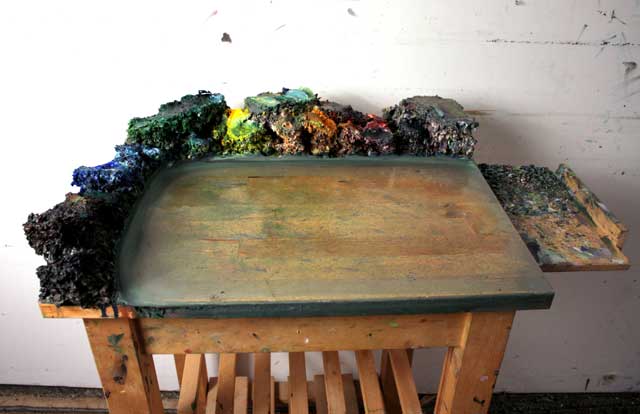
2015 Palette
LG: Anything special about your painting technique? What paints do you put out on your palette? Anything note-worthy about how you paint?
KM: I don’t think so. I have included a photo of my palette if it’s of any interest to you or your readers. I have been buying almost all my paint from RGH, a small paint manufacturer from upstate NY. I use a pretty common set of about 20 colors. This is the order they appear on my palette:
- Lead and Titanium white (mixed)
- Burnt Umber
- Burnt Sienna
- Ultramarine Blue
- Cobalt Blue
- Phthalo Blue
- Cerulean Blue
- Phthalo Green
- Sap Green
- Viridian Green
- Cadmium Yellow Light
- Cadmium Yellow Lemon
- Cadmium Yellow Medium
- Sometimes Bright Yellow, Jaune Brilliant, or something similar
- Yellow Ochre
- Indian Red
- Mars Orange
- Alizarin Crimson
- Cadmium Red
- Dioxazine Violet
I use a very small amount of medium: 1/3 cold-pressed linseed oil, 1/3 Linquin, 1/3 Gamsol
LG: Many of your paintings, especially your landscapes, have an impressive level of naturalistic light and color, why is this important to you?
KM: That’s very simple. The world is a beautiful place!
People connect very quickly to paintings with naturalistic color. It reminds us of our shared experience.
LG: You are teaching a painting workshop at the JSS in Civita this summer in Civita Castellana, Italy.July 20th—August 3rd. Can you tell us something about how you go about teaching your workshop there? What has been your attraction to the JSS in Civita?
KM: I am very proud to be associated with the JSS. And I am honored that Israel Hershberg has asked me to come back to teach this year. I think that Israel and Yael Scalia have set up an amazing program in Civita. It’s hard to imagine a better opportunity for someone interested in landscape painting than to go work from the same sites that Corot used to make such pivotal paintings. Of course there is no shortage of amazing landscape to paint in Italy, but the opportunity to study alongside so many other artists is what makes this program special. This year’s guest of honor is Ann Gale, who I think is a fabulous painter. I purposely scheduled my class so that my students and I will be there at the same time as Ann. I am also looking forward to meeting some very impressive master class students and artist-in-residence painters as well. I really think this confluence of people is the real reason to go. As I mentioned earlier, I feel like painting with other artists is the best way to learn. Even if you only get a glimpse at the way they approach their craft.
We are all such visual and experiential learners—so in my class I will do a lot of demonstrating. I often paint along with my students so that they can see how I think my way through a painting. The core of my teaching is helping students to see and translate what is important to them into a successful painting. Often this means simplifying a complex landscape into more manageable pieces and identifying which colors are most crucial for creating space. My class is open to anyone interested in working directly from the landscape to improve their painting. It’s going to be a great experience—and I still have a few spots left!
LG: What is most important to you about painting?
KM: At least once a month I walk into my studio and I feel like my paintings are all wrong. I never feel like I have been wasting my time -but I often feel like I am standing at the bottom of a big mountain and I have a long way to go.
So I feel like the struggle has important role to play in painting. But so does the feeling of connection to a larger world and the moments of pure joy that come when everything seems to be falling into place.


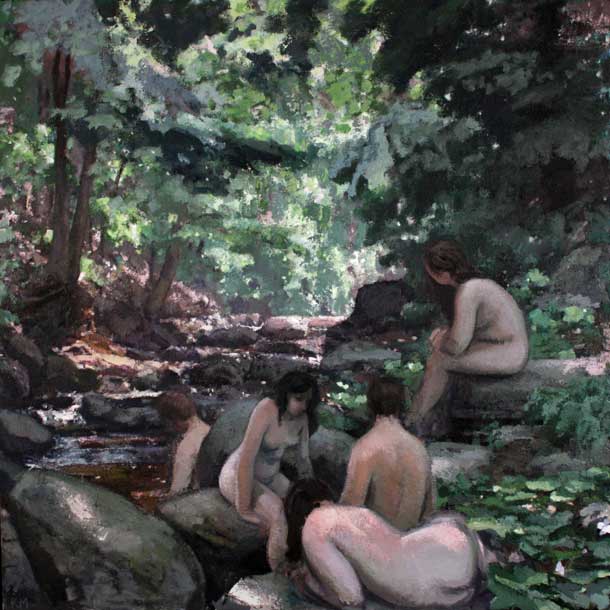
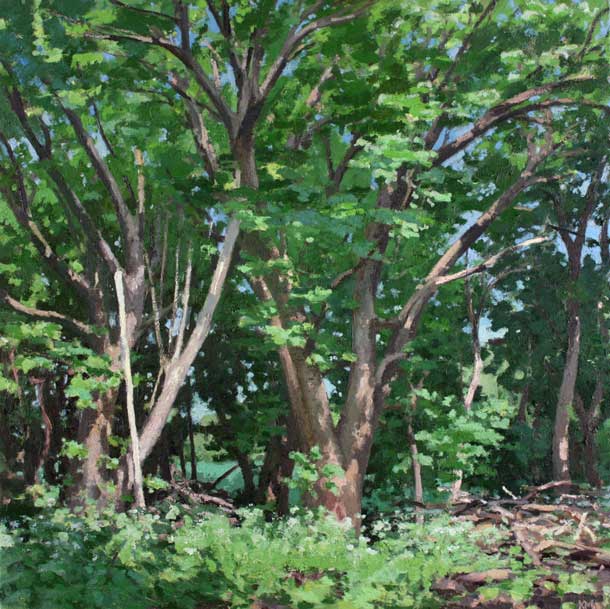
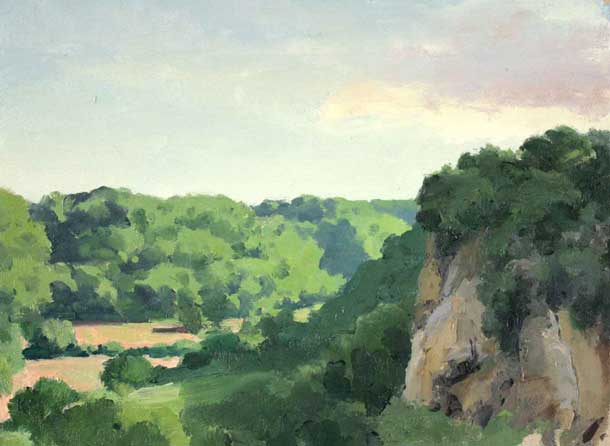

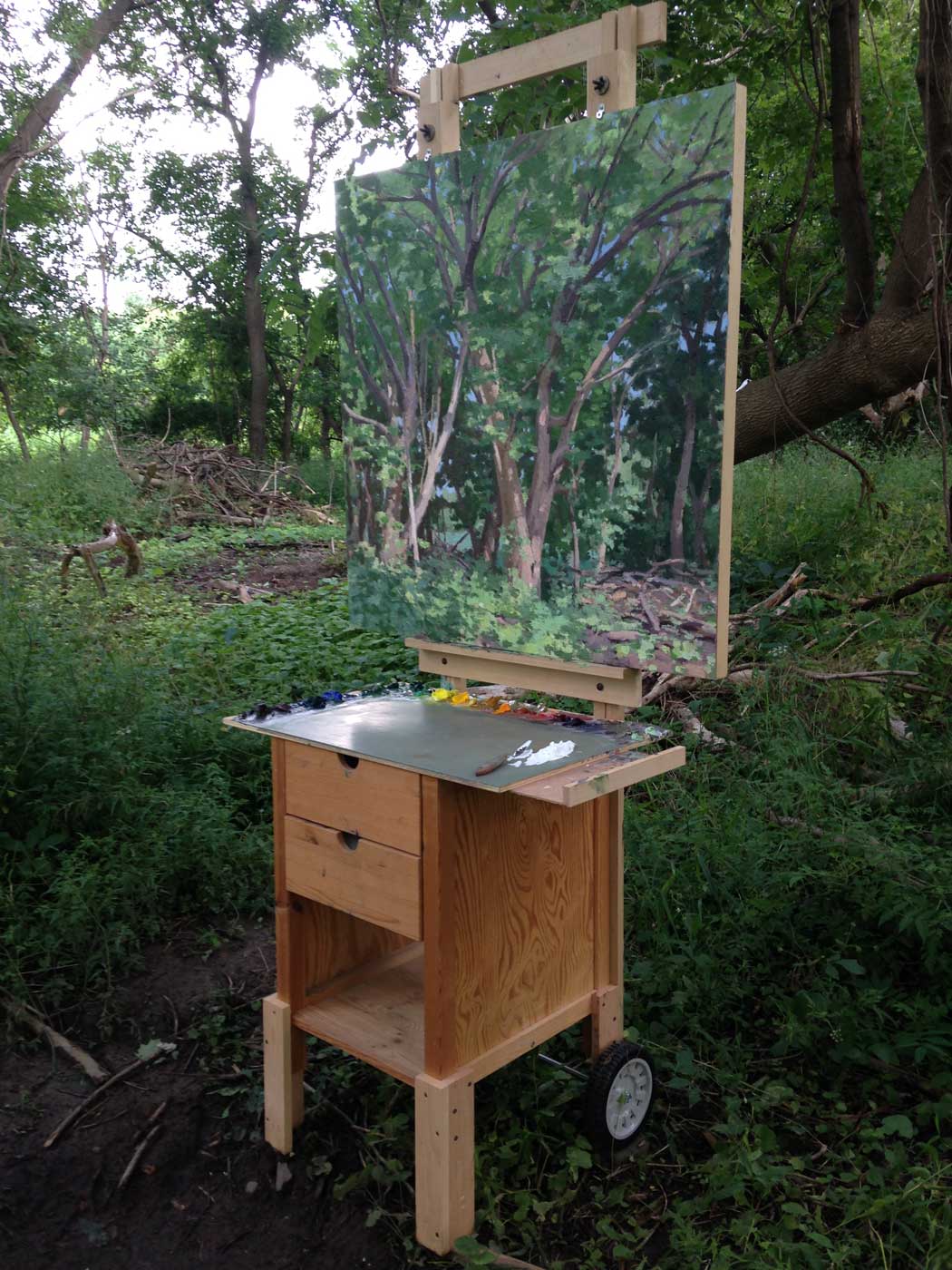
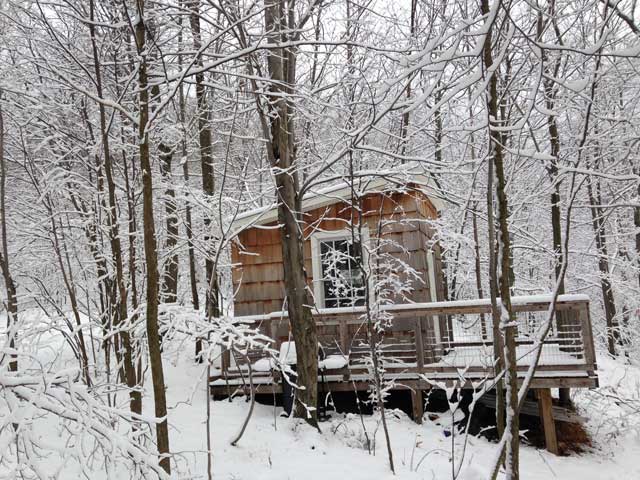
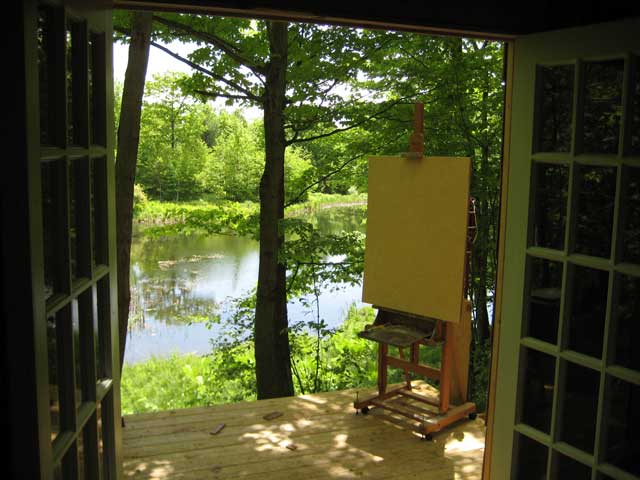
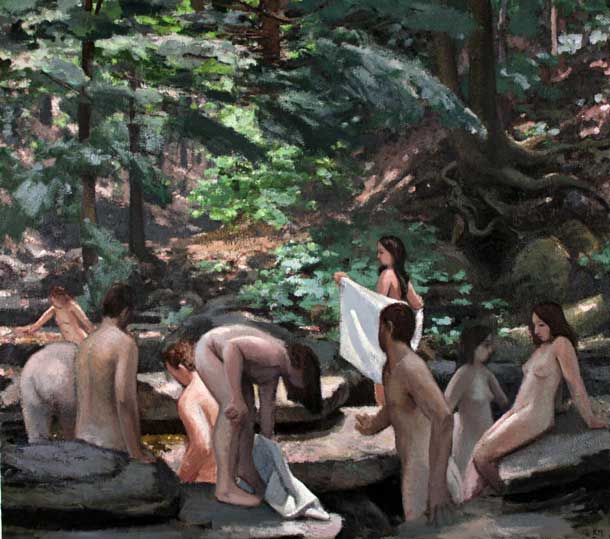
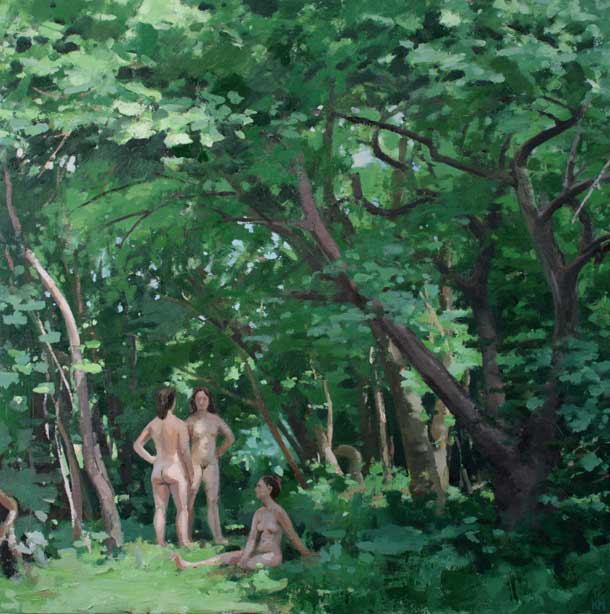
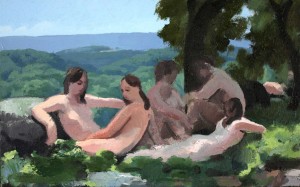
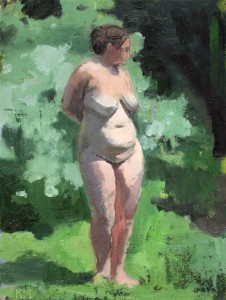
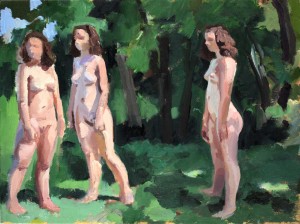

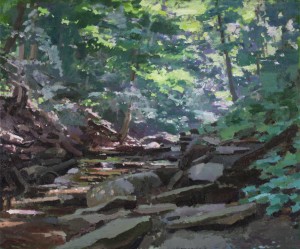
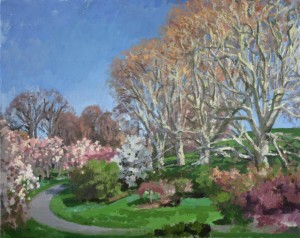
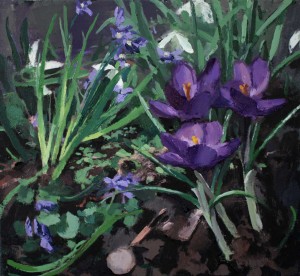
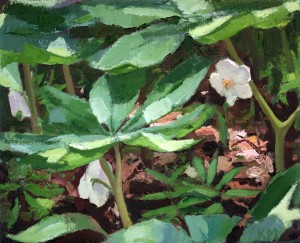
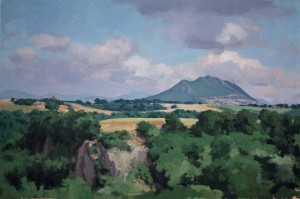
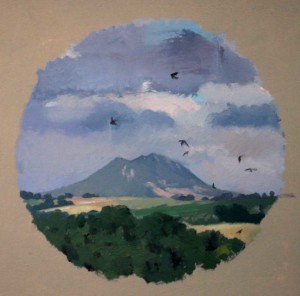
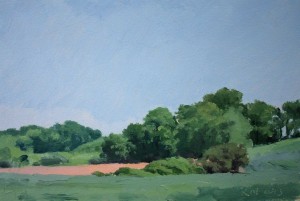




Wonderful article and photos. I will be in Civita with Kurt in July and look forward to the experience.
great article! And very nice landscapes. Reminds me a bit of Welliver too
Great interview. Great site. As a former classmate, it is nice to happen upon these articles. Great work, Kurt!
It’s amazing how much information a strong painter can encode in brusque paint. The figures are alive and so is the light. Beautiful! I found myself smiling with each new image in the article.
Dear Kurt.
I was so glad to have come across this interview and images of your recent work.
Congratulations on your accomplishments as an artist, and teacher. You are so accomplished,.. I am recalling your being an exceptional student in my 2D class so many years ago. What an amazing trajectory, one that promises to be a continually upward one. I so admire you, Kurt.